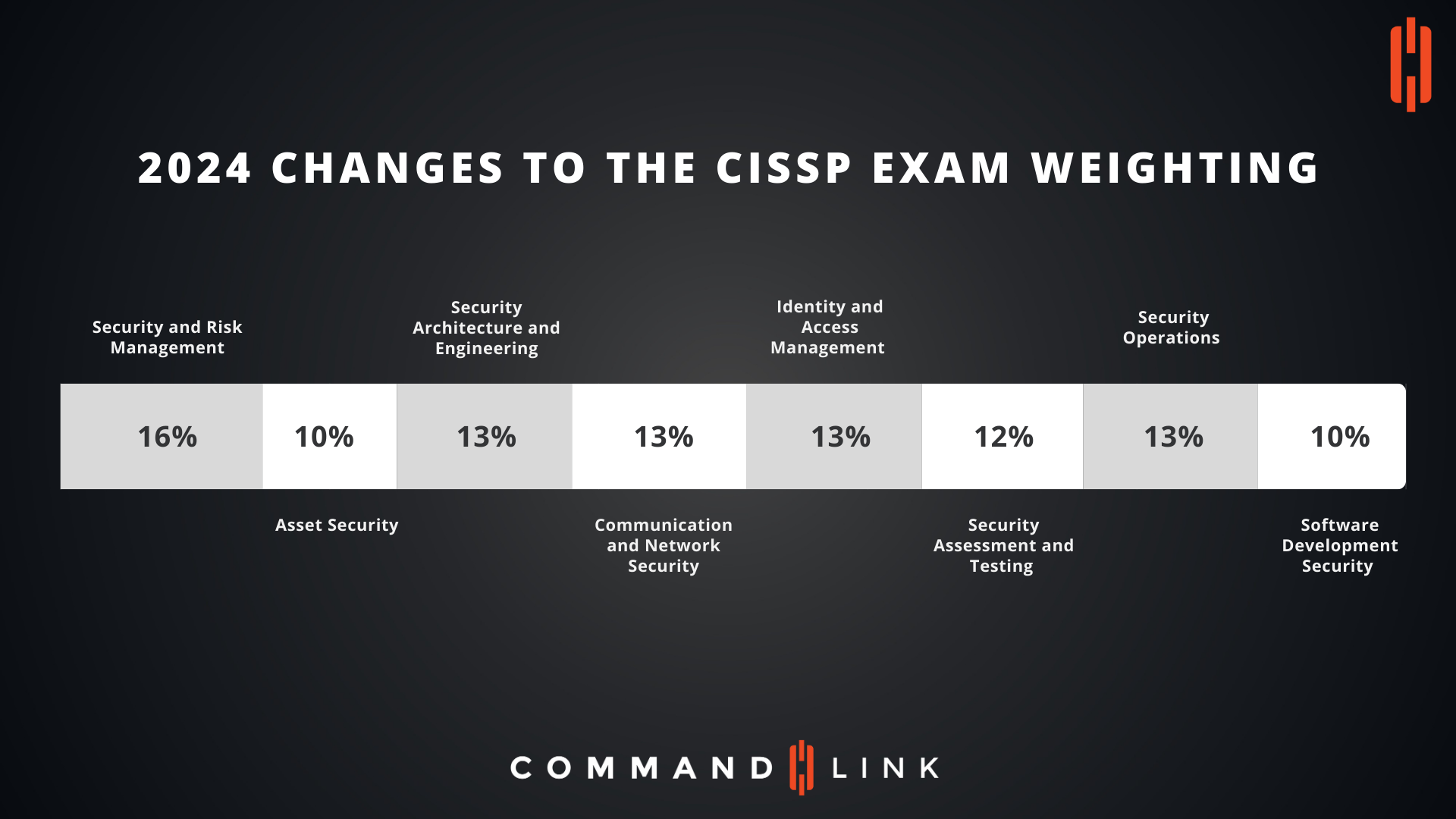Platform
Platform
Everything you need to run a secure global network—in a single system.
Solutions
Solutions
Learn how our solutions were designed to help you scale your IT resources
Company
CommandLink
Let's talk about how we can help you!
Partners

This article provides an in-depth look at the 2024 changes to the CISSP exam weighting, breaking down the importance of each domain and how these adjustments impact your preparation strategy.
1. Security and Risk Management (16%)
Security and Risk Management remains the most heavily weighted domain in the CISSP exam, accounting for 16% of the overall score. This domain covers the fundamental principles of information security, including risk management, security governance, legal and regulatory issues, and business continuity planning. The continued emphasis on this domain reflects the importance of understanding and managing risk in a constantly evolving threat landscape.
For exam candidates, this means that a strong grasp of risk management concepts, frameworks, and methodologies is essential. Understanding how to assess and mitigate risks, as well as how to align security practices with business objectives, will be critical to success in this domain.
2. Asset Security (10%)
Asset Security, which focuses on the protection of organizational assets, has a weighting of 10%. This domain covers the concepts of asset management, data classification, and handling requirements, ensuring that sensitive information is adequately protected throughout its lifecycle.
In 2024, the weighting for this domain has remained consistent, highlighting the ongoing need for professionals to be proficient in managing and securing both physical and digital assets. Candidates should be familiar with best practices for data protection, including encryption, data masking, and access controls.
3. Security Architecture and Engineering (13%)
Security Architecture and Engineering, weighted at 13%, encompasses the design and implementation of secure networks, systems, and applications. This domain covers topics such as security models, cryptography, and secure design principles.
The weighting of this domain indicates its critical role in building and maintaining a secure IT infrastructure. Exam candidates should focus on understanding how to design secure systems that are resilient against attacks, as well as how to integrate security into the development lifecycle.
4. Communication and Network Security (13%)
Communication and Network Security, also weighted at 13%, deals with the secure design and management of enterprise networks. This domain covers network architecture, protocols, secure communication channels, and network security controls.
Given the rise of sophisticated network-based attacks, such as man-in-the-middle attacks and advanced persistent threats, this domain remains a significant focus of the CISSP exam. Candidates must be well-versed in network security principles, including the design and implementation of firewalls, intrusion detection systems, and secure network configurations.
5. Identity and Access Management (13%)
Identity and Access Management (IAM), another domain with a 13% weighting, involves the management of identities and access controls within an organization. This domain includes topics such as authentication, authorization, identity federation, and access management technologies.
As organizations continue to adopt cloud services and remote work models, IAM has become increasingly important. Candidates should be prepared to demonstrate their understanding of how to manage user identities securely, implement multifactor authentication, and ensure that access controls are aligned with the principle of least privilege.
6. Security Assessment and Testing (12%)
Security Assessment and Testing, weighted at 12%, focuses on evaluating and testing the security posture of an organization's systems and networks. This domain includes topics such as vulnerability assessments, penetration testing, and audit processes.
The weighting of this domain reflects the importance of regular security assessments in identifying and addressing vulnerabilities before they can be exploited. Candidates should be knowledgeable about the various methods and tools used for security testing, as well as how to interpret and respond to assessment results.
7. Security Operations (13%)
Security Operations, which covers the day-to-day management of an organization's security infrastructure, is also weighted at 13%. This domain includes topics such as incident response, disaster recovery, logging and monitoring, and security operations center (SOC) management.
The focus on Security Operations highlights the need for professionals to be adept at detecting, responding to, and recovering from security incidents. Candidates should be familiar with best practices for incident management, including the development of incident response plans and the use of security information and event management (SIEM) systems.
8. Software Development Security (10%)
Software Development Security, with a 10% weighting, addresses the security aspects of the software development lifecycle (SDLC). This domain includes topics such as secure coding practices, software testing, and the integration of security into the development process.
As software vulnerabilities continue to be a leading cause of security breaches, this domain remains a crucial part of the CISSP exam. Candidates should understand how to implement security controls at each stage of the SDLC and how to identify and mitigate common software vulnerabilities.
The 2024 changes to the CISSP exam weighting underscore the evolving priorities in the field of information security. With the increasing complexity of cyber threats, the CISSP certification continues to emphasize a broad and deep understanding of security principles across multiple domains.
Candidates preparing for the CISSP exam should pay close attention to these weightings, as they reflect the areas where they will need to demonstrate the most proficiency. A well-rounded study plan that covers each domain in proportion to its weighting will be key to achieving certification success.
Staying up-to-date with the latest trends and best practices in cybersecurity will not only help candidates pass the exam but also equip them with the skills needed to protect their organizations in an ever-changing threat landscape.